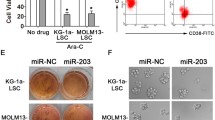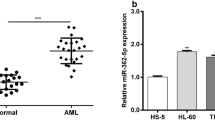Abstract
microRNAs (miRNAs) play critical roles in many different cellular processes, including metabolism, apoptosis, differentiation and development. We showed miR-181b to be highly expressed in acute myeloid leukemia (AML). Furthermore, miR-181b contributed to proliferation of AML cells by targeting MLK2. Our results demonstrated that miR-181b plays an important role in the biology of AML and may be useful in developing therapies targeting miRNAs.
Similar content being viewed by others
References
Löwenberg B, Downing J R, Burnett A. Acute myeloid leukemia. N Engl J Med, 1999, 341: 1051–1062, 10.1056/NEJM199909303411407, 10502596
Wheatley K, Burnett A K, Goldstone A H, et al. A simple, robust, validated and highly predictive index for the determination of risk-directed therapy in acute myeloid leukemia derived from the MRC AML 10 trial. Br J Haematol, 1999, 107: 69–79, 10.1046/j.1365-2141.1999.01684.x, 1:STN:280:DyaK1MvltV2ntw%3D%3D, 10520026
Kottaridis P D, Gale R E, Frew M E, et al. The presence of a FLT3 internal tandem duplication in patients with acute myeloid leukemia (AML) adds important prognostic information to cytogenetic risk group and response to the first cycle of chemotherapy: Analysis of 854 patients from the United Kingdom Medical Research Council AML 10 and 12 trials. Blood, 2001, 98: 1752–17599, 10.1182/blood.V98.6.1752, 1:CAS:528:DC%2BD3MXntFWgsbg%3D, 11535508
Whitman S P, Archer K J, Feng L, et al. Absence of the wild-type allele predicts poor prognosis in adult de novo acute myeloid leukemia with normal cytogenetics and the internal tandem duplication of FLT3: A cancer and leukemia group B study. Cancer Res, 2001, 61: 7233–7239, 1:CAS:528:DC%2BD3MXnsVeht7c%3D, 11585760
Xie X, Lu J, Kulbokas E J, et al. Systematic discovery of regulatory motifs in human promoters and 3′UTRs by comparison of several mammals. Nature, 2005, 434: 338–345, 10.1038/nature03441, 1:CAS:528:DC%2BD2MXit1yqsrk%3D, 15735639
Lewis B P, Burge C B, Bartel D P. Conserved seed pairing, often flanked by adenosines,indicates that thousands of human genes are microRNA targets. Cell, 2005, 120: 15–20, 10.1016/j.cell.2004.12.035, 1:CAS:528:DC%2BD2MXot1ChsA%3D%3D, 15652477
Bartel D P. MicroRNAs: Genomics, biogenesis, mechanism, and function. Cell, 2004, 116: 281–297, 10.1016/S0092-8674(04)00045-5, 1:CAS:528:DC%2BD2cXhtVals7o%3D, 14744438
Hiyoshi Y, Kamohara H, Karashima R, et al. microRNA-21 Regulates the Proliferation and Invasion in Esophageal Squamous Cell Carcinoma. Clin Cancer Res, 2009, 15: 1915–1922, 10.1158/1078-0432.CCR-08-2545, 1:CAS:528:DC%2BD1MXjtF2rsL0%3D, 19276261
Aguda B D, Kim Y, Piper-Hunter M G, et al. microRNA regulation of a cancer network: Consequences of the feedback loops involving miR-17-92, E2F, and Myc. Proc Natl Aead Sci USA, 2008, 105: 19678–19683, 10.1073/pnas.0811166106, 1:CAS:528:DC%2BD1cXhsFCltr3O
Mathonnet G, Fabian M R, Svitkin Y V, et al. microRNA inhibition of translation initiation in vitro by targeting the cap-binding complex eIF4F. Science, 2007, 317: 1764–1767, 10.1126/science.1146067, 1:CAS:528:DC%2BD2sXhtVGmsLbO, 17656684
Garzon R, Volinia S, Liu C G, et al. microRNA signatures associated with cytogenetics and prognosis in acute myeloid leukemia. Blood. 2008, 111: 3183–3189, 10.1182/blood-2007-07-098749, 1:CAS:528:DC%2BD1cXjvVamtbY%3D, 18187662
Mi S, Lu J, Sun M, et al. microRNA expression signatures accurately discriminate acute lymphoblastic leukemia from acute myeloid leukemia. Proc Natl Acad Sci USA, 2007, 104: 19971–19976, 10.1073/pnas.0709313104, 1:CAS:528:DC%2BD1cXhs1Wmtw%3D%3D, 18056805
Dixon-McIver A, East P, Mein C A, et al. Distinctive patterns of microRNA expression associated with karyotype in acute myeloid leukaemia. PLoS ONE, 2008, 3: e2141, 10.1371/journal.pone.0002141, 18478077
Marcucci G, Radmacher M D, Maharry K, et al. microRNA expression in cytogenetically normal acute myeloid leukemia. N Engl J Med, 2008, 358: 1919–1928, 10.1056/NEJMoa074256, 1:CAS:528:DC%2BD1cXlt1Gnsr0%3D, 18450603
Xi Y, Formentini A, Chien M, et al. Prognostic Values of microRNAs in colorectal cancer. Biomark Insights, 2006, 2: 113–121, 18079988
Pallante P, Visone R, Ferracin M, et al. microRNA deregulation in human thyroid papillary carcinomas. Endocr Relat Cancer, 2006, 13: 497–508, 10.1677/erc.1.01209, 1:CAS:528:DC%2BD28XntF2mtLc%3D, 16728577
Pekarsky Y, Santanam U, Cimmino A, et al. Tcl1 expression in chronic lymphocytic leukemia is regulated by miR-29 and miR-181. Cancer Res, 2006, 66: 11590–11593, 10.1158/0008-5472.CAN-06-3613, 1:CAS:528:DC%2BD28XhtlagurjF, 17178851
Wu W, Pew T, Zou M, et al. Glucocorticoid Receptor-induced MAPK phosphatase-1 (MPK-1) expression inhibits paclitaxel-associated MAPK activation and contributes to breast cancer cell survival. J Biol Chem, 2005, 280: 4117–4124, 10.1074/jbc.M411200200, 1:CAS:528:DC%2BD2MXhtVyntbo%3D, 15590693
Valledor A F, Arpa L, Sánchez-Tilló E, et al. IFN -“gamma”-mediated inhibition of MAPK phosphatase expression results in prolonged MAPK activity in response to M-CSF and inhibition of proliferation. Blood, 2008, 112: 3274–3282, 10.1182/blood-2007-11-123604, 1:CAS:528:DC%2BD1cXht1OmurzI, 18682602
Takada Y, Sethi G, Sung B, et al. Flavopiridol suppresses tumor necrosis factor-Induced activation of activator Protein-1, c-Jun N-Terminal Kinase, p38 Mitogen-Activated Protein Kinase (MAPK), p44/p42 MAPK, and Akt, inhibits expression of antiapoptotic gene products, and enhances apoptosis through cytochrome c Release and caspase activation in human myeloid cells. Mol Pharmacol, 2008, 73: 1549–1557, 10.1124/mol.107.041350, 1:CAS:528:DC%2BD1cXlsVWgu7k%3D, 18287248
Kim J M, White J M, Shaw A S, et al. MAPK p38 alpha is dispensable for lymphocyte development and proliferation. J Immunol, 2005, 174: 1239–1244, 1:CAS:528:DC%2BD2MXlsFyhsg%3D%3D, 15661878
Tran S E, Holmstrom T H, Ahonen M, et al. MAPK/ERK Overrides the apoptotic signaling from Fas, TNF, and TRAIL receptors. J Biol Chem, 2001, 276: 16484–16490, 10.1074/jbc.M010384200, 1:CAS:528:DC%2BD3MXjvFarsro%3D, 11278665
Chen C, Ridzon D A, Broomer A J, et al. Real-time quantification of microRNAs by stem-loop RT-PCR. Nucleic Acids Res, 2005, 33: e179, 10.1093/nar/gni178, 16314309
Shi L, Cheng Z, Zhang J, et al. hsa-mir-181a and hsa-mir-181b function as tumor suppressors in human glioma cells. Brain Res, 2008, 1236: 185–193, 10.1016/j.brainres.2008.07.085, 1:CAS:528:DC%2BD1cXht1SitL%2FE, 18710654
de Yébenes V G, Belver L, Pisano D G, et al. MiR-181b negatively regulates activation-induced cytidine deaminase in B cells. J Exp Med, 2008, 205: 2199–2206, 10.1084/jem.20080579, 18762567
Nakajima G, Hayashi K, Xi Y, et al. Non-coding microRNAs hsa-let-7g and hsa-miR-181b are Associated with Chemoresponse to S-1 in Colon Cancer. Cancer Genomics Proteomics, 2006, 3: 317–324, 1:CAS:528:DC%2BD28XhtFygsrjL, 18172508
Phelan D R, Price G, Liu Y F, et al. Activated JNK phosphorylates the c-terminal domain of MLK2 that is required for MLK2-induced apoptosis. J Biol Chem, 2001, 276: 10801–10810, 10.1074/jbc.M008237200, 1:CAS:528:DC%2BD3MXjvFCqtbo%3D, 11278395
Xu Z, Maroney A C, Dobrzanski P, et al. The MLK family mediates c-Jun N-Terminal kinase activation in neuronal apoptosis. Mol Cell Biol, 2001, 21: 4713–4724, 10.1128/MCB.21.14.4713-4724.2001, 1:CAS:528:DC%2BD3MXks1Gju7k%3D, 11416147
Kim K Y, Kim B C, Xu Z, et al. Mixed lineage kinase 3 (MLK3)-activated p38 MAP kinase mediates transforming growth factor-β-induced apoptosis in hepatoma cells. J Biol Chem, 2004, 279: 29478–29484, 10.1074/jbc.M313947200, 1:CAS:528:DC%2BD2cXlsVCmurk%3D, 15069087
Liu Y F, Dorow D, Marshall J. Activation of MLK2-mediated signaling cascades by polyglutamine-expanded Huntingtin. J Biol Chem, 2000, 275: 19035–19040, 10.1074/jbc.C000180200, 1:CAS:528:DC%2BD3cXksVGktbg%3D, 10801775
Robinson M J, Cobb M H. Mitogen-activated kinase pathways. Curr Opin Cell Biol, 1997, 9: 180–186, 10.1016/S0955-0674(97)80061-0, 1:CAS:528:DyaK2sXisVWntLk%3D, 9069255
Rana A, Gallo K, Godowski P, et al. The mixed lineage kinase SPRK phosphorylates and activates the stress-activated protein kinase activator, SEK-1. J Biol Chem, 1996, 271: 19025–19028, 10.1074/jbc.271.32.19025, 1:CAS:528:DyaK28XkvFynsrs%3D, 8702571
Tibbles L A, Ing Y L, Kiefer F, et al. MLK-3 activates the SAPK/JNK and p38/RK pathways via SEK1 and MKK3/6. EMBO J, 1996, 15: 7026–7035, 1:CAS:528:DyaK2sXosFClsA%3D%3D, 9003778
Teramoto H, Coso O A, Miyata H, et al. Signaling from the small GTP-binding proteins Rac1 and Cdc42 to the c-Jun N-terminal kinase/stress-activated protein kinase pathway. A role for mixed lineage kinase 3/protein-tyrosine kinase 1, a novel member of the mixed lineage kinase family. J Biol Chem, 1996, 271: 27225–27228, 10.1074/jbc.271.8.3963, 1:CAS:528:DyaK28XmvVWmsr8%3D, 8910292
Hirai S, Katoh M, Terada M, et al. MST/MLK2, a member of the mixed lineage kinase family, directly phosphorylates and activates SEK1, an activator of c-Jun N-terminal kinase/stress-activated protein kinase. J Biol Chem, 1997, 272: 15167–15173, 10.1074/jbc.272.24.15167, 1:CAS:528:DyaK2sXjvFOntb4%3D, 9182538
Zhong J, Kyriakis J M. Dissection of a signaling pathway by which pathogen-associated molecular patterns recruit the JNK and p38 MAPKs and trigger cytokine release. J Biol Chem, 2007, 282: 24246–24254, 10.1074/jbc.M703422200, 1:CAS:528:DC%2BD2sXoslOnuro%3D, 17584736
Brown L, Benchimol S. The involvement of MAPK signaling pathways in determining the cellular response to p53 activation: cell cycle arrest or apoptosis. J Biol Chem, 2006, 281: 3832–3840, 10.1074/jbc.M507951200, 1:CAS:528:DC%2BD28XhtlKksbw%3D, 16330547
Pruitt K, Pruitt W M, Bilter G K, et al. Raf-independent deregulation of p38 and JNK mitogen-activated protein kinases are critical for ras transformation. J Biol Chem. 2002, 277: 31808–31817, 10.1074/jbc.M203964200, 1:CAS:528:DC%2BD38XmslOqtLc%3D, 12082106
Author information
Authors and Affiliations
Corresponding author
Rights and permissions
About this article
Cite this article
Chen, H., Chen, Q., Fang, M. et al. microRNA-181b targets MLK2 in HL-60 cells. Sci. China Life Sci. 53, 101–106 (2010). https://doi.org/10.1007/s11427-010-0002-y
Received:
Accepted:
Published:
Issue Date:
DOI: https://doi.org/10.1007/s11427-010-0002-y




